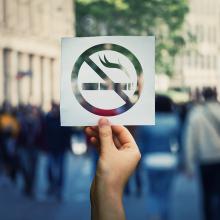Commercial Tobacco Prevention and Treatment Program: Smoke-Free Air
Smoke-free air is good for Wisconsin
Secondhand smoke is the smoke that people inhale when others are smoking cigarettes or other commercial tobacco products like cigars or cigarillos.
In recent years, this topic has expanded to include secondhand vapor, or aerosol, released when people use e-cigarettes.
Exposure to secondhand smoke and aerosol is a proven health threat. Laws that protect smoke-free air are good for all Wisconsinites.
- Secondhand smoke contains hundreds of toxic and cancer-causing chemicals.
- Exposure to this smoke can cause coronary heart disease, stroke, and lung cancer.
- Children are especially vulnerable to secondhand smoke. They can experience respiratory infections, asthma, and slowed lung growth.
- Secondhand smoke especially harms older adults’ heart and respiratory health.
- E-cigarettes, or vapes, release aerosols into the air. These tiny droplets contain harmful substances including nicotine, heavy metals, volatile organic compounds (VOCs), and ultrafine particulates that are known to cause cancer.
There is no safe level of exposure to secondhand smoke and aerosol. Smoke-free air policies are the only effective way to protect people. Ventilation systems and other so-called mitigation methods are not effective at eliminating these health risks.
Since 2010, Wisconsinites have been protected from the danger of secondhand smoke by Wisconsin's statewide smoke-free air law (PDF). The law protects everyone, including children, bar and restaurant workers, employees, and customers, from secondhand smoke.
- Wisconsin’s smoke-free air law prohibits the smoking of cigars, cigarettes, pipes, or other lighted smoking devices indoors in public spaces.
- Wisconsin’s law does not currently include e-cigarettes, or vapes. Some counties and municipalities have already added vaping to their local smoke-free air policies.
- In 2023, 77.6% of Wisconsinites supported the prohibition of smoking in most public places, including all workplaces, public buildings, offices, restaurants, and bars; 18.3% neither support nor oppose; and only 4.2% oppose the clean indoor air law. (Source: Wisconsin Behavioral Risk Factor Survey (PDF)).
- In addition, 61.4% of Wisconsinites also supported strengthening the law to include the prohibition of vaping indoors in public spaces.
- When the Wisconsin Smoke-free Air Law was passed in 2010, only cigar bars in existence at that time were allowed to remain.
Strengthening and protecting Wisconsin’s smoke-free air law promotes equity. It ensures that all Wisconsinites have the right to breathe clean air while working or visiting public spaces.
- Smoke-free air laws are linked to a reduction of health issues and hospital admissions for restaurant and bar workers.
- Smoke-free laws are linked to hospital cost savings.
- Smoke-free air laws normalize and promote tobacco-free and nicotine-free lifestyles. Since Wisconsin’s smoke-free air law was enacted, youth cigarette use has significantly decreased.
Wisconsin communities recognize the importance of smoke-free environments. Many work to strengthen protections against secondhand smoke and aerosol.
Strengthening local smoke-free air laws
The indoor smoke-free air law does not currently offer protection against secondhand exposure to e-cigarette aerosols or smoke from other substances that are smoked or vaped, like cannabis. Some counties and municipalities across the state have updated their smoke-free air ordinances to include these devices.
Some municipalities have also made outdoor public spaces smoke-free. Many have passed policies that prevent smoking and vaping on public properties, such as parks, beaches, and fairgrounds.
Smoke-free housing
Smoke-free housing policies are an equity issue. This means all residents, regardless of their financial situation, deserve to have a stable and healthy living environment, including the right to breathe smoke-free air at home.
Property managers across the state successfully implement smoke-free policies to make their entire property, including individual units and outdoor spaces, 100% smoke-free. Since 2018, the United States Department of Housing and Urban Development also requires that all public housing be smoke-free.
- Secondhand smoke cannot be contained in one room. In multi-unit housing, smoke moves from unit to unit through ventilation systems, plumbing, doorways, and walls.
- Smoke-free housing policies reduce the health problems caused by secondhand smoke and the risk of fire and promote overall safety.
- Smoke-free housing initiatives also support people to maintain smoke-free lifestyles and increase attempts to quit smoking.
Tobacco-free campuses
Tobacco-free policies protect students, faculty, staff, and campus visitors from involuntary exposure to secondhand smoke and aerosols. It also can motivate students to get help to quit. Tobacco-free campus policies establish tobacco-free and vape-free lifestyles as the norm.
Wisconsin’s SPARK program has supported colleges and universities across the state to pass tobacco-free policies and educate communities on the harmful health effects of commercial tobacco.
More trusted smoke-free air resources
- Campaign for Tobacco-Free Kids
- American Non-Smokers' Rights Foundation
- CDC (Centers for Disease Control and Prevention)
- Secondhand Aerosol, American non-Smokers' Rights
Get free help to quit commercial tobacco and nicotine
Wisconsin Tobacco Quit Line
Customized plans and coaching
Ages 13+
800-Quit-Now
Text "READY" to 34191
WI Tobacco Quit Line website
Live Vape Free
Text support to quit e-cigarettes
Ages 13-26
Text "VAPEFREE" to 873373
Live Vape Free website
American Indian Quit Line
Culturally tailored coaching
Ages 18+
888-7Ai-Quit
American Indian Quit Line website
First Breath
Support during and after pregnancy
Ages 18+
First Breath website
The word "tobacco" on this page refers to commercial tobacco, not traditional Native American tobacco
Traditional tobacco: a sacred medicine for healing; offerings to the Creator; and spiritual gifts to express gratitude, show respect, and ask for prayers or advice. Commercial tobacco ("tobacco"): a corruption of traditional tobacco into dangerous recreational commodities like cigarettes, vapes, and chewing tobacco.


